Timeline

Legend:
- Orange denotes Liao monarchs
- Teal denotes Northern Liao monarchs
- Pink denotes Western Liao monarchs
There were nine emperors of the Liao dynasty . The Liao dynasty was a Khitan-led dynasty of China that at its height ruled over what is now Shanxi, Hebei, Liaoning, Jilin, Heilongjiang, and Inner Mongolia provinces in China, as well as portions of the Korean peninsula, portions of the Russian Far East, and much of the Mongolian Plateau. [1] [2]
For emperors of the Northern Liao and Qara Khitai (Western Liao), see Northern Liao#Monarchs and Qara Khitai#Sovereigns of Qara Khitai.
| Temple Names (Miao Hao 廟號 miàohào) | Posthumous Names (Shi Hao 諡號 shìhào) | Birth Names | Period of Reigns | Era Names (Nian Hao 年號 niánhào) and their according range of years |
|---|---|---|---|---|
| Convention: "Liao" + temple name except Liao Tianzuodi who is referred using "Liao" + posthumous name | ||||
| Taizu (太祖 Tàizǔ) | Shen Tian Huangdi | Yelü Abaoji (耶律阿保機 Yēlǜ Ābǎojī) | 916-926 | Shence (神冊 Shéncè) 916-922 [3] Tianzan (天贊 Tiānzàn) 922-926 [4] |
| Taizong (太宗 Tàizōng) | Xiao Wu Huangdi | Yelü Deguang (耶律德光 Yēlǜ Déguāng) | 926-947 | Tianxian (天顯 Tiānxiǎn) 926-937 [5] Huitong (會同 Huìtóng) 937-947 [6] Datong (大同 Dàtóng) 947 [7] |
| Shizong (世宗 Shìzōng) | Tian Shou Huangdi | Yelü Ruan (耶律阮 Yēlǜ Ruǎn) | 947-951 | Tianlu (天祿 Tiānlù) 947-951 [8] |
| Muzong (穆宗 Mùzōng) | Yelü Jing (耶律璟 Yēlǜ Jǐng) | 951-969 | Yingli (應曆 Yìnglì) 951-969 [9] | |
| Jingzong (景宗 Jǐngzōng) | Yelü Xian (耶律賢 Yēlǜ Xián) | 969-982 | Baoning (保寧 Bǎoníng) 969-979 [10] Qianheng (乾亨 Qiánhēng) 979-982 [11] | |
| Shengzong (聖宗 Shèngzōng) | Wen Wu Da Xiao Xuan Huangdi | Yelü Longxu (耶律隆緒 Yēlǜ Lóngxù) | 982-1031 | Qianheng (乾亨 Qiánhēng) 982 [11] Tonghe (統和 Tǒnghé) 983-1012 [12] Kaitai (開泰 Kāitài) 1012-1021 [13] Taiping (太平 Tàipíng) 1021-1031 [14] |
| Xingzong (興宗 Xīngzōng) | Xiao Zheng Huangdi | Yelü Zongzhen (耶律宗真 Yēlǜ Zōngzhēn) | 1031–1055 | Jingfu (景福 Jǐngfú) 1031-1032 [15] Chongxi (重熙 Chóngxī) 1032-1055 [16] |
| Daozong (道宗 Dàozōng) | Yelü Hongji (耶律洪基 Yēlǜ Hóngjī) | 1055–1101 | Qingning (清寧 Qīngníng) 1055-1064 [17] Xianyong (咸雍 Xiányōng) 1065-1074 [18] Taikang (太康 Tàikāng) or Dakang (大康 Dàkāng) 1075-1084 [19] Da'an (大安 Dà'ān) 1085-1094 [20] Shouchang (壽昌 Shòuchāng) or Shoulong (壽隆 Shòulóng) 1095-1101 [21] | |
| Tianzuodi (天祚帝 Tiānzuòdì) | Yelü Yanxi (耶律延禧 Yēlǜ Yánxǐ) | 1101–1125 | Qiantong (乾統 Qiántǒng) 1101-1110 [22] Tianqing (天慶 Tiānqìng) 1111-1120 [23] Baoda (保大 Bǎodà) 1121-1125 [24] | |
| Yelü clan - Liao dynasty | |||||||||||||||||||||||||||||||||||||||||||||||||||||||||||||||||||||||||||||||||||||||||||||||||||||||||||||||||||||||||||||||||||||||||||||||||||||||||||||||||||||||||||||||||||||||||||||||||||||||||||||||||||||||||||||||||||||||||||||||||||||||||||||||||||||||||||||||||||||||||||||||||||||||||||||||||||||||||||||||||||||||||||||||||||||||||||||||||||||||||||||||||||||||||||||||||||||||||||||||||||||||||||||||||||||||||||||||||||||||||||||||||||||||||||||||||||||||||||||||||||||||||||||||||||||||||||||||||||||||||||||||||||||||||||||||||||||||||||||||||||||||||||||||||||||||||||||||||||||||||||||||||||||||||||||||||||||||||||||||||||||||||||||||||||||||||||||||||||||||||||||||||||||||||||||||||||||||||||||||||||||||||||||||||||||||||||||||||||||||||||||||||||||||||||||||||||||||||||||||||||||||||||||||||||||||||||||||||||||||||||||||||||||||||||||||||||||||||||||||||||||||||||||||||||||||||||||||||||||||||||||||||||||||||||||||||||||||||||||||||||||||||||||||||||||||||||||||||||||||
|---|---|---|---|---|---|---|---|---|---|---|---|---|---|---|---|---|---|---|---|---|---|---|---|---|---|---|---|---|---|---|---|---|---|---|---|---|---|---|---|---|---|---|---|---|---|---|---|---|---|---|---|---|---|---|---|---|---|---|---|---|---|---|---|---|---|---|---|---|---|---|---|---|---|---|---|---|---|---|---|---|---|---|---|---|---|---|---|---|---|---|---|---|---|---|---|---|---|---|---|---|---|---|---|---|---|---|---|---|---|---|---|---|---|---|---|---|---|---|---|---|---|---|---|---|---|---|---|---|---|---|---|---|---|---|---|---|---|---|---|---|---|---|---|---|---|---|---|---|---|---|---|---|---|---|---|---|---|---|---|---|---|---|---|---|---|---|---|---|---|---|---|---|---|---|---|---|---|---|---|---|---|---|---|---|---|---|---|---|---|---|---|---|---|---|---|---|---|---|---|---|---|---|---|---|---|---|---|---|---|---|---|---|---|---|---|---|---|---|---|---|---|---|---|---|---|---|---|---|---|---|---|---|---|---|---|---|---|---|---|---|---|---|---|---|---|---|---|---|---|---|---|---|---|---|---|---|---|---|---|---|---|---|---|---|---|---|---|---|---|---|---|---|---|---|---|---|---|---|---|---|---|---|---|---|---|---|---|---|---|---|---|---|---|---|---|---|---|---|---|---|---|---|---|---|---|---|---|---|---|---|---|---|---|---|---|---|---|---|---|---|---|---|---|---|---|---|---|---|---|---|---|---|---|---|---|---|---|---|---|---|---|---|---|---|---|---|---|---|---|---|---|---|---|---|---|---|---|---|---|---|---|---|---|---|---|---|---|---|---|---|---|---|---|---|---|---|---|---|---|---|---|---|---|---|---|---|---|---|---|---|---|---|---|---|---|---|---|---|---|---|---|---|---|---|---|---|---|---|---|---|---|---|---|---|---|---|---|---|---|---|---|---|---|---|---|---|---|---|---|---|---|---|---|---|---|---|---|---|---|---|---|---|---|---|---|---|---|---|---|---|---|---|---|---|---|---|---|---|---|---|---|---|---|---|---|---|---|---|---|---|---|---|---|---|---|---|---|---|---|---|---|---|---|---|---|---|---|---|---|---|---|---|---|---|---|---|---|---|---|---|---|---|---|---|---|---|---|---|---|---|---|---|---|---|---|---|---|---|---|---|---|---|---|---|---|---|---|---|---|---|---|---|---|---|---|---|---|---|---|---|---|---|---|---|---|---|---|---|---|---|---|---|---|---|---|---|---|---|---|---|---|---|---|---|---|---|---|---|---|---|---|---|---|---|---|---|---|---|---|---|---|---|---|---|---|---|---|---|---|---|---|---|---|---|---|---|---|---|---|---|---|---|---|---|---|---|---|---|---|---|---|---|---|---|---|---|---|---|---|---|---|---|---|---|---|---|---|---|---|---|---|---|---|---|---|---|---|---|---|---|---|---|---|---|---|---|---|---|---|---|---|---|---|---|---|---|---|---|---|---|---|---|---|---|---|---|---|---|---|---|---|---|---|---|---|---|---|---|---|---|---|---|---|---|---|---|---|---|---|---|---|---|---|---|---|---|---|---|---|---|---|---|---|---|---|---|---|---|---|---|---|---|---|---|---|---|---|---|---|---|---|---|---|---|---|---|---|---|---|---|---|---|---|---|---|---|---|---|---|---|---|---|---|---|---|---|---|---|---|---|---|---|---|---|---|---|---|---|---|---|---|---|---|---|---|---|---|---|---|---|---|---|---|---|---|---|---|---|---|---|---|---|---|---|---|---|---|---|---|---|---|---|---|---|---|---|---|---|---|---|---|---|---|---|---|---|---|---|---|---|---|---|---|---|---|---|---|---|---|---|---|---|---|---|---|---|---|---|---|---|---|---|---|---|---|---|---|---|---|---|---|---|---|---|---|---|---|---|---|---|---|---|---|---|---|---|---|---|---|---|---|---|---|---|---|---|---|---|---|---|---|---|---|---|---|---|---|---|---|---|---|---|---|---|---|---|---|---|---|---|---|---|---|---|---|---|---|---|---|---|---|---|---|---|---|---|---|---|---|---|---|---|---|---|---|---|---|---|---|---|---|---|---|---|---|---|---|---|---|---|---|---|---|---|---|---|---|---|---|---|---|---|---|---|---|---|---|---|---|---|---|---|---|---|---|---|---|---|---|---|---|---|---|---|---|---|---|---|---|---|---|---|---|---|---|---|---|---|---|---|---|---|---|---|---|---|---|---|---|---|---|---|---|---|---|---|---|---|---|
| |||||||||||||||||||||||||||||||||||||||||||||||||||||||||||||||||||||||||||||||||||||||||||||||||||||||||||||||||||||||||||||||||||||||||||||||||||||||||||||||||||||||||||||||||||||||||||||||||||||||||||||||||||||||||||||||||||||||||||||||||||||||||||||||||||||||||||||||||||||||||||||||||||||||||||||||||||||||||||||||||||||||||||||||||||||||||||||||||||||||||||||||||||||||||||||||||||||||||||||||||||||||||||||||||||||||||||||||||||||||||||||||||||||||||||||||||||||||||||||||||||||||||||||||||||||||||||||||||||||||||||||||||||||||||||||||||||||||||||||||||||||||||||||||||||||||||||||||||||||||||||||||||||||||||||||||||||||||||||||||||||||||||||||||||||||||||||||||||||||||||||||||||||||||||||||||||||||||||||||||||||||||||||||||||||||||||||||||||||||||||||||||||||||||||||||||||||||||||||||||||||||||||||||||||||||||||||||||||||||||||||||||||||||||||||||||||||||||||||||||||||||||||||||||||||||||||||||||||||||||||||||||||||||||||||||||||||||||||||||||||||||||||||||||||||||||||||||||||||||||

Legend:

Turkestan, also spelled Turkistan, is a historical region in Central Asia corresponding to the regions of Transoxiana and East Turkistan (Xinjiang). Turkestan is primarily inhabited by Turkic peoples, including Uzbeks, Oghuz Turks, Kazakhs, Khazars, Kyrgyz, and Uyghurs. The region hosts Russian and Tajik-Persian minorities. Turkestan is subdivided into Afghan Turkestan, Russian Turkestan, and East Turkistan. Today, "Turkestan" mainly refers to Xinjiang, where Turkic peoples constitute more than half of the population.

The Qara Khitai, or Kara Khitai, also known as the Western Liao, officially the Great Liao, was a dynastic regime based in Central Asia ruled by the Yelü clan of the Khitan people. Being a rump state of the Khitan-led Liao dynasty, Western Liao was culturally Sinicized to a large extent, especially among the elites consisting of Liao refugees.
Area codes 905, 289, 365, and 742 are telephone area codes in the North American Numbering Plan (NANP) for the Golden Horseshoe region that surrounds Lake Ontario in Southern Ontario, Canada. The numbering plan area (NPA) comprises (clockwise) the Niagara Peninsula, the city of Hamilton, the regional municipalities of Halton, Peel, York, Durham, and parts of Northumberland County, but excludes the City of Toronto.
Taizu is a temple name typically, but not always, used for Chinese monarchs who founded a particular dynasty, may refer to:
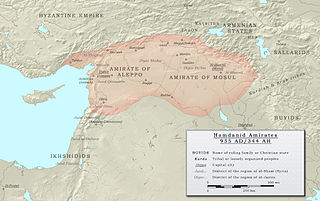
The Hamdanid dynasty was a Shia Muslim Arab dynasty of Northern Mesopotamia and Syria (890–1004). They descended from the ancient Banu Taghlib tribe of Mesopotamia and Arabia.

Area code 701 is a telephone area code in the North American Numbering Plan (NANP) for the U.S. State of North Dakota. It is one of the 86 original North American area codes created by AT&T in 1947, and continues to be the only area code in North Dakota, one of eleven states with only one area code.
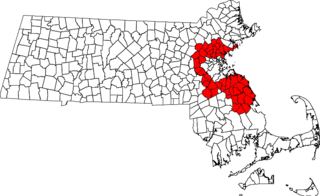
Area code 781 and 339 are telephone area codes in the North American Numbering Plan for the U.S. state of Massachusetts. The numbering plan area consists of Boston’s inner suburbs, known as the Route 128 corridor, and some outer suburbs, especially in the South Shore region. It was created as in an area code split of area code 617 on September 1, 1997. Use of 781 became mandatory February 1, 1998. Area code 339 is an overlay complex code for the same service area, activated on May 2, 2001. Since then, ten-digit dialing has been mandatory.
Area codes 778, 236, and 672 are telephone area codes in the North American Numbering Plan (NANP) for the Canadian province of British Columbia. They form an overlay complex with area code 604, which serves only a small southwestern section, the Lower Mainland, of the province, and area code 250, which serves the rest of the province.
The Yelü clan, alternatively rendered as Yila or Yarud, was a prominent family of ethnic Khitan origin in the history of China. The clan assumed leadership of the Khitan tribal confederation in 907 when Abaoji was made khagan. In 916, Abaoji founded the Liao dynasty. After the fall of the Liao dynasty in 1125, members of the Yelü family continued to play significant roles in history, most notably for ruling the Western Liao and during the Mongols era of conquest in the 13th century. Yelü Chucai, the last recorded person to be able to speak and read the Khitan language, is notable for advising Genghis Khan in the Confucian tradition.
The chancellor was a semi-formally designated office position for a number of high-level officials at one time during the Tang dynasty of China. This list also includes chancellors of the short-lived Wu Zhou dynasty, which is typically treated as an interregnum of the Tang dynasty by historians.
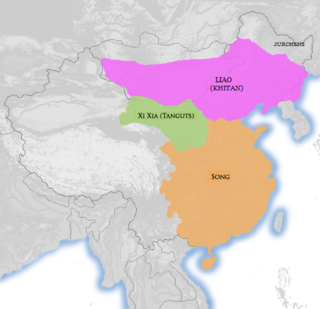
The Liao dynasty was a Khitan-led imperial dynasty of China. This article discusses the provincial system that existed within the Liao dynasty from the early 10th century until the fall of the empire in 1125, in what is now North China, Northeast China and Mongolia.
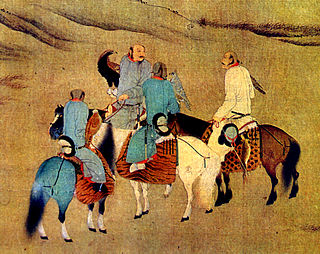
The Khitan people were a historical nomadic people from Northeast Asia who, from the 4th century, inhabited an area corresponding to parts of modern Mongolia, Northeast China and the Russian Far East.
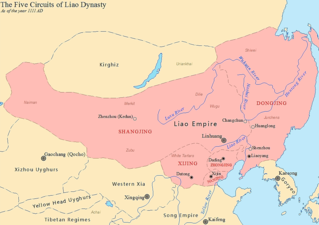
The Liao dynasty, also known as the Khitan Empire, officially the Great Liao, was an imperial dynasty of China that existed between 916 and 1125, ruled by the Yelü clan of the Khitan people. Founded around the time of the collapse of the Tang dynasty, at its greatest extent it ruled over Northeast China, the Mongolian Plateau, the northern part of the Korean Peninsula, southern portions of the Russian Far East, and the northern tip of the North China Plain.

The Liao dynasty was a Khitan-led dynasty of China that ruled over parts of Northern China, Manchuria, the Mongolian Plateau, northern Korean Peninsula, and what is modern-day Russian Far East from 916 until 1125 when it was conquered by the Jin dynasty. Remnants of the Liao court fled westward and created the Western Liao dynasty which in turn was annexed by the Mongol Empire in 1218.
Yelü Zhilugu was the third emperor of the Western Liao dynasty, ruling from 1177 to 1211. As the final ruler from the House of Yelü, he is considered by traditional Chinese sources to be the last monarch of the Western Liao dynasty.